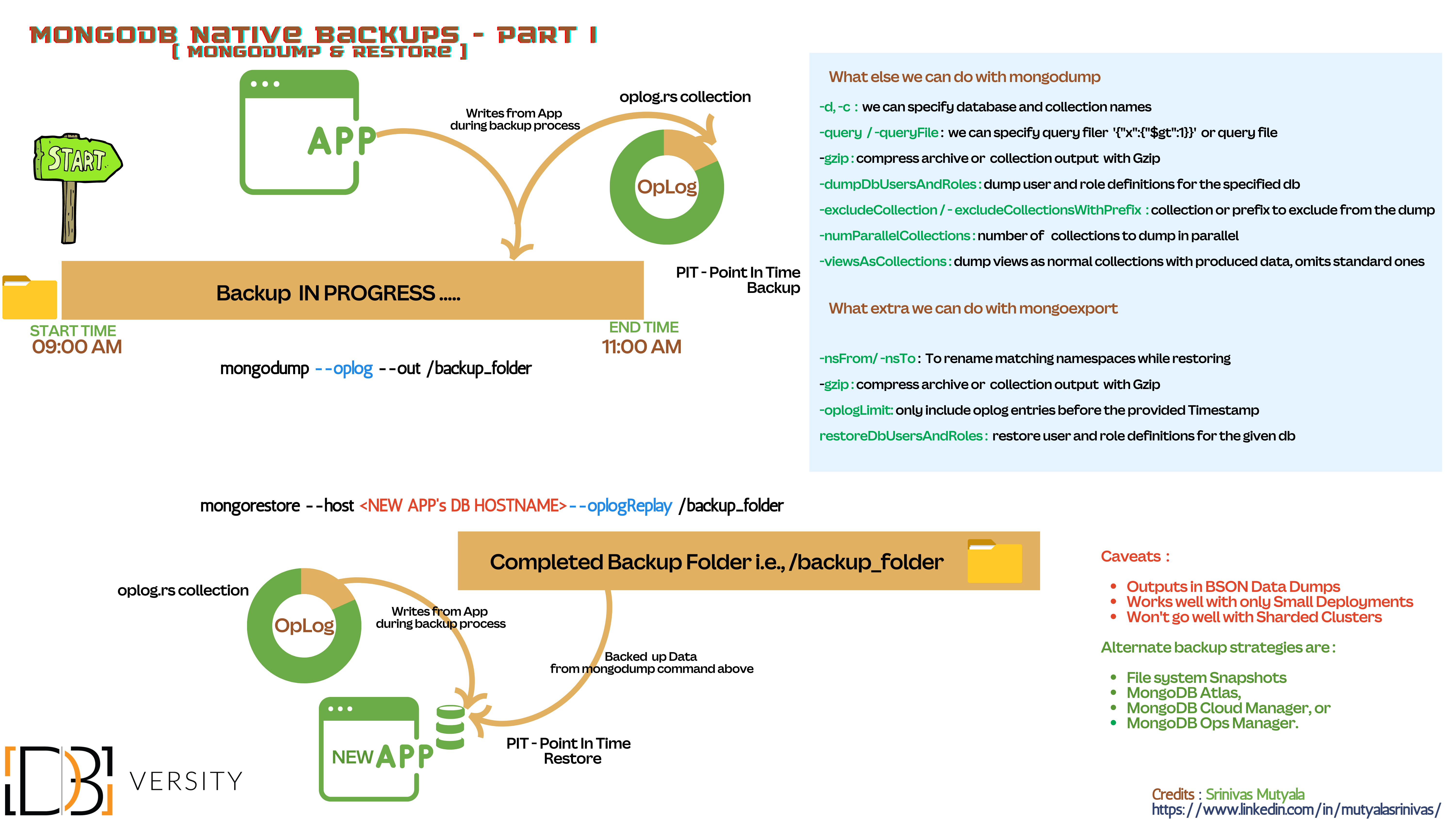MongoDB Backup Strategies : Part 1
mongodump and mongorestore are command-line tools provided by MongoDB to create backups of databases using the BSON data format (Binary JSON). These tools allow you to export and import data from MongoDB instances.
- mongodump:
mongodumpis used to create a binary export of the contents of a MongoDB database. It generates a full backup of the data, including collections, indexes, users, and other metadata.
Syntax:
mongodump --host <hostname><:port> --db <database> --out <output-directory>
--host: Specifies the MongoDB server’s hostname and optional port number.--db: Specifies the name of the database to be exported.--out: Specifies the directory path where the backup files will be stored.
Example:
mongodump --host localhost --db mydatabase --out /path/to/backup/directory
This command exports the mydatabase database from the local MongoDB server and saves the backup files in the /path/to/backup/directory.
- mongorestore:
mongorestoreis used to restore data from amongodumpbackup. It reads BSON data files created bymongodumpand inserts them into a specified MongoDB database.
Syntax:
mongorestore --host <hostname><:port> --db <database> <input-directory>
--host: Specifies the MongoDB server’s hostname and optional port number.--db: Specifies the name of the target database where the data will be restored.<input-directory>: Specifies the path to the directory containing the backup files created bymongodump.
Example:
mongorestore --host localhost --db mydatabase /path/to/backup/directory
This command restores the data from the backup files located in the /path/to/backup/directory and inserts it into the mydatabase database on the local MongoDB server.
Note: Both mongodump and mongorestore support additional options for specifying authentication credentials, SSL connections, and other settings. You can refer to the MongoDB documentation for more information on advanced usage and available options.
To cover other options :
mongodump --host <hostname><:port> --db <database> --username <username> --password <password> --authenticationDatabase <auth-db> --out <output-directory> --gzip
--host: Specifies the MongoDB server’s hostname and optional port number.--db: Specifies the name of the database to be exported.--username: Specifies the username for authentication (optional).--password: Specifies the password for authentication (optional).--authenticationDatabase: Specifies the authentication database (optional).--out: Specifies the output directory path where the backup files will be stored.--gzip: Compresses the backup files using gzip compression (optional).
Example:
mongodump --host localhost --db mydatabase --username myuser --password mypassword --authenticationDatabase admin --out /path/to/backup/directory --gzip
This command exports the mydatabase database from the local MongoDB server, authenticating with the username and password, and saves the compressed backup files in the /path/to/backup/directory directory.
- mongorestore:
mongorestoreis a command-line tool used to restore MongoDB backups created bymongodump.
Syntax:
mongorestore --host <hostname><:port> --db <database> --username <username> --password <password> --authenticationDatabase <auth-db> --dir <input-directory> --gzip
--host: Specifies the MongoDB server’s hostname and optional port number.--db: Specifies the name of the target database where the data will be restored.--username: Specifies the username for authentication (optional).--password: Specifies the password for authentication (optional).--authenticationDatabase: Specifies the authentication database (optional).--dir: Specifies the path to the directory containing the backup files created bymongodump.--gzip: Specifies that the backup files are compressed using gzip (optional).
Example:
mongorestore --host localhost --db mydatabase --username myuser --password mypassword --authenticationDatabase admin --dir /path/to/backup/directory --gzip
This command restores the data from the backup files located in the /path/to/backup/directory, authenticating with the username and password, and inserts it into the mydatabase database on the local MongoDB server.
Note: Both mongodump and mongorestore support additional options for specifying SSL connections, handling BSON types, and other settings. You can refer to the MongoDB documentation for more information on advanced usage and available options.
Limitations :
- Single-threaded operation: By default,
mongodumpandmongorestoreoperate in a single-threaded manner, meaning they perform operations sequentially. This can result in slower backup and restore times, especially for large databases. However, you can use the--numParallelCollectionsoption inmongorestoreto enable parallel processing for collections, which can improve performance. - Database-level backup and restore:
mongodumpandmongorestorework at the database level, meaning they export and import the entire contents of a database. It is not possible to selectively backup or restore individual collections or documents. If you need more granular control over the data, you may need to use alternative methods such as writing custom scripts or using MongoDB’smongoexportandmongoimporttools. - No real-time backup:
mongodumpcreates a point-in-time snapshot of the data at the time of execution. It does not provide real-time continuous backup capabilities. If data changes whilemongodumpis running, the backup will not reflect those changes. To achieve continuous backup, you can consider other options such as replication, sharding, or third-party backup solutions. - Compatibility limitations: When restoring a backup using
mongorestore, the MongoDB server version should be equal to or higher than the version used during themongodumpoperation. Attempting to restore a backup into an older MongoDB version may cause compatibility issues. - Storage requirements: Both
mongodumpandmongorestoregenerate BSON files as backups. These files can consume a significant amount of disk space, especially for large databases. Ensure that you have sufficient storage capacity to accommodate the backup files during the process. - Backup consistency: While
mongodumpcreates a consistent snapshot of the data, there is a possibility of data changes occurring during the backup process. If the data is modified whilemongodumpis running, the backup may not reflect a fully consistent state of the database at a single point in time.
It’s essential to consider these limitations and evaluate whether mongodump and mongorestore meet your specific backup and restore requirements. Depending on your use case, you may need to explore additional tools or techniques to address specific limitations or to achieve more specialized backup and restore functionalities.


Comments are closed, but trackbacks and pingbacks are open.